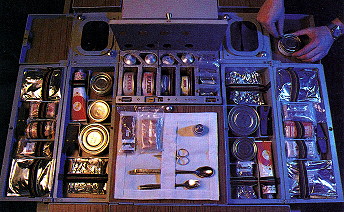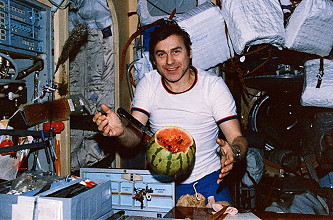Human Orbital Spaceflights
![]()
International Flight No. 114Soyuz TM-3Soyuz TM-2VityazUSSR |
 |
![]()
Launch, orbit and landing data
walkout photo |
 |
|||||||||||||||||||||||||||||||
alternative crew photo |
alternative crew photo |
|||||||||||||||||||||||||||||||
alternative crew photo |
alternative crew photo |
|||||||||||||||||||||||||||||||
alternative crew photo |
alternative crew photo |
|||||||||||||||||||||||||||||||
Crew
| No. | Surname | Given names | Position | Flight No. | Duration | Orbits | |
| 1 | Viktorenko | Aleksandr Stepanovich | Commander | 1 | 7d 23h 04m 55s | 126 | |
| 2 | Aleksandrov | Aleksandr Pavlovich | Flight Engineer | 2 | 160d 07h 16m 19s | 2537 | |
| 3 | Faris | Muhammed Achmed | Research Cosmonaut | 1 | 7d 23h 04m 55s | 126 |
Crew seating arrangement
|
 |
|
||||||||||||||||
Backup Crew
|
 |
||||||||||||||||||||
alternative crew photo |
|||||||||||||||||||||
alternative crew photo |
|||||||||||||||||||||
alternative crew photo |
|||||||||||||||||||||
alternative crew photo |
Hardware
| Launch vehicle: | Soyuz-U2 (No. I15000-019) |
| Spacecraft: | Soyuz TM-3 (7K-STM No. 53) |
Flight
|
Launch from the Baikonur Cosmodrome and
landing with Soyuz TM-2 spacecraft 78
km northeast of Arkalyk. After launch the Soyuz TM-3 maneuvered from an initial 231 x 217 km orbit to Mir's 311 x 359 km orbit. Following a two-day solo flight Soyuz TM-3 docked the with the rear port of the Mir space station on July 24, 1987. The spacecraft automatically docked to the Kvant1 port, but they had to use a lever to break the hatch's seal. Aleksandr Aleksandrov became Aleksandr Laveykin's replacement aboard Mir, becoming Yuri Romanenko's new partner. The visiting expedition observed Syria (Euphrat experiment) and conducted materials processing experiments, but also biological experiments. Among other tasks, they carried out a series of measurements on the Bosra experiment, designed to obtain new information on the physical processes at work in the upper layers of the atmosphere and in the ionosphere, while yet another installation, the Ruckey, was used to purify genetically-engineered interferon and a drug to combat influenza. The purpose of yet another installation on Mir, Svetlana, was to isolate active microorganisms producing antibodies for use in stock farming. The results of the Euphrates experiment were keenly awaited in Syria. While flying over that country, the cosmonauts carried out a series of visual observations, photographed its territory and performed a spectrometric survey. The data they collected would make it possible, with more accuracy, to define Syria's agro-resources, and help both geologists and hydrologists. One of the experiments requiring special and unique care involved the use of the Kristallizator furnace. Even during designated rest periods, it had been determined that any movements by the cosmonauts could create sufficient vibrations to affect the delicate crystallization process. In the case of Mir, experimental work would not be carried out in the space station itself, but in one of the specially equipped experimental modules docked with it. Syrian guest cosmonaut Muhammed Faris and Soviet cosmonaut Aleksandr Viktorenko returned to Earth in Soyuz TM-2 with Aleksandr Laveykin, who was diagnosed by ground-based doctors as having minor heart problems. The spacecraft undocked from Mir at 08:34 UTC on July 29, 1987. The Orbital Module was jettisoned before retrofire and left in a 308 x 356 km orbit. Soyuz TM-2 landed at 01:04 UTC with the crew of Muhammed Faris, Aleksandr Laveykin and Aleksandr Viktorenko aboard. The Soyuz spacecraft is composed of three elements attached end-to-end - the Orbital Module, the Descent Module and the Instrumentation/Propulsion Module. The crew occupied the central element, the Descent Module. The other two modules are jettisoned prior to re-entry. They burn up in the atmosphere, so only the Descent Module returned to Earth. The deorbit burn lasted 219.2 seconds. Having shed two-thirds of its mass, the Soyuz reached Entry Interface - a point 400,000 feet (121.9 kilometers) above the Earth, where friction due to the thickening atmosphere began to heat its outer surfaces. With only 23 minutes left before it lands on the grassy plains of central Asia, attention in the module turned to slowing its rate of descent. Eight minutes later, the spacecraft was streaking through the sky at a rate of 755 feet (230 meters) per second. Before it touched down, its speed slowed to only 5 feet (1.5 meter) per second, and it lands at an even lower speed than that. Several onboard features ensure that the vehicle and crew land safely and in relative comfort. Four parachutes, deployed 15 minutes before landing, dramatically slowed the vehicle's rate of descent. Two pilot parachutes were the first to be released, and a drogue chute attached to the second one followed immediately after. The drogue, measuring 24 square meters (258 square feet) in area, slowed the rate of descent from 755 feet (230 meters) per second to 262 feet (80 meters) per second. The main parachute was the last to emerge. It is the largest chute, with a surface area of 10,764 square feet (1,000 square meters). Its harnesses shifted the vehicle's attitude to a 30-degree angle relative to the ground, dissipating heat, and then shifted it again to a straight vertical descent prior to landing. The main chute slowed the Soyuz to a descent rate of only 24 feet (7.3 meters) per second, which is still too fast for a comfortable landing. One second before touchdown, two sets of three small engines on the bottom of the vehicle fired, slowing the vehicle to soften the landing. |
Note
Relocations of Manned Spacecrafts
| Spacecraft | from | Undocking | Time UTC | to | Redocking | Time UTC |
| Soyuz TM-3 | Mir - Kvant | 30.07.1987 | 23:27:49 | Mir - Baseblock | 30.07.1987 | 23:47:41 |
Photos / Graphics
 |
 |
 |

Credit: GTCT |
 |
 |
 |
 |
 |
 |
 |
 |
 |
 |
 |
 |
 |
 |
 |
 |
| © |  |
Last update on March 29, 2025.  |
 |